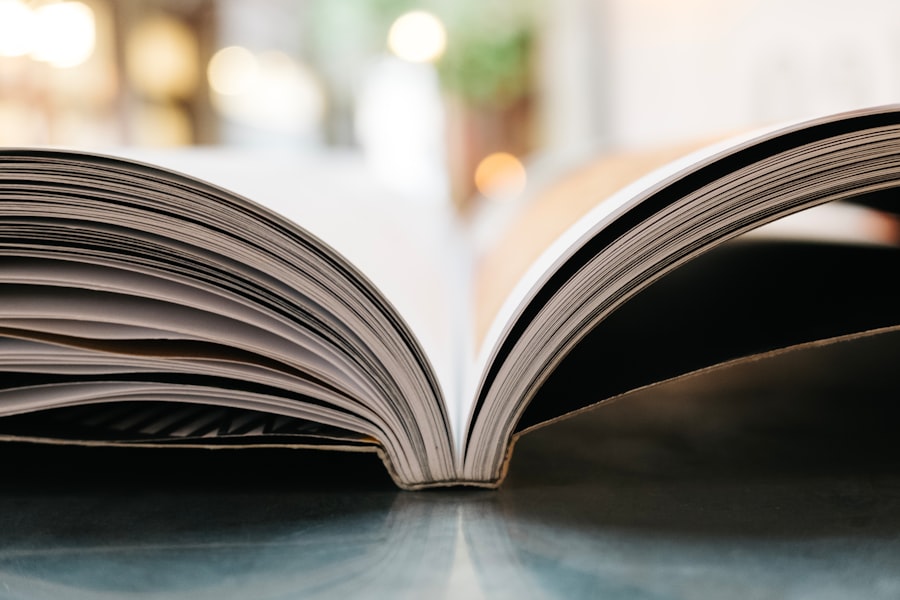
Book to Film: The Art of Adaptation
Book-to-film adaptations have become increasingly popular in recent years, with audiences flocking to theaters to see their favorite stories come to life on the big screen. From beloved classics to contemporary bestsellers, books have provided a rich source of material for filmmakers to adapt into visually stunning and emotionally resonant films. However, with the popularity of these adaptations comes the challenge of staying true to the source material while also making creative choices that enhance the cinematic experience. In this article, we will explore the evolution of book-to-film adaptations, the challenges faced by filmmakers, the importance of staying true to the source material, and the future of this ever-evolving industry.
Key Takeaways
- Book-to-film adaptations have a long history, dating back to the early days of cinema.
- Adapting books into films presents numerous challenges, from condensing the story to capturing the essence of the characters.
- Staying true to the source material is crucial for filmmakers, as fans of the book will be looking for familiar elements in the film.
- Screenwriters play a vital role in book-to-film adaptations, helping to translate the story from page to screen.
- Visual storytelling is a powerful tool for filmmakers, allowing them to bring the world of the book to life on screen.
The Evolution of Book-to-Film Adaptations: A Brief History
Book-to-film adaptations have been around for as long as cinema itself. In the early days of filmmaking, adaptations were often limited by technological constraints and the limitations of silent film. However, as technology advanced and sound was introduced to cinema, filmmakers began to explore more ambitious adaptations. Hollywood quickly recognized the potential of adapting popular books, and studios began acquiring the rights to novels and turning them into box office hits.
The impact of technology on book-to-film adaptations cannot be overstated. With advancements in special effects and CGI, filmmakers are now able to bring fantastical worlds and creatures to life in ways that were once unimaginable. This has opened up a whole new realm of possibilities for adaptations, allowing filmmakers to create visually stunning and immersive experiences for audiences.
The Challenges of Adapting Books into Films: A Comprehensive Guide
Adapting a book into a film is no easy task. Filmmakers must strike a delicate balance between staying faithful to the source material and making creative choices that enhance the cinematic experience. One of the biggest challenges is addressing the differences in medium and audience. Books and films are fundamentally different forms of storytelling, with their own unique strengths and limitations. Filmmakers must find ways to translate the essence of a book onto the screen, while also making adjustments to suit the visual medium and engage a wider audience.
Another challenge is handling fan expectations and criticism. When a beloved book is adapted into a film, fans often have high expectations and can be quick to criticize any deviations from the source material. Filmmakers must navigate this delicate terrain, understanding that while it is important to honor the original material, they also have a responsibility to make creative choices that serve the story and the medium of film.
The Importance of Staying True to the Source Material: Tips for Filmmakers
| Metrics | Importance |
|---|---|
| Box Office Revenue | Higher chance of success as fans of the source material are more likely to watch the film |
| Critical Reception | Better reviews as staying true to the source material can lead to a more cohesive and well-developed story |
| Fan Satisfaction | Increased fan satisfaction as they feel their beloved source material has been respected and accurately portrayed |
| Brand Reputation | Positive impact on the brand reputation as it shows a commitment to quality and attention to detail |
| Future Adaptations | Higher likelihood of future adaptations as staying true to the source material can build a loyal fan base and increase demand for more content |
While there are challenges in adapting books into films, it is crucial for filmmakers to stay true to the source material. This means understanding the themes and tone of the book and finding ways to translate them onto the screen. By staying true to the essence of the book, filmmakers can create a more authentic and resonant adaptation that will satisfy both fans of the book and new audiences.
Another important aspect of staying true to the source material is honoring the characters and their arcs. Characters are often what make a book memorable, and it is essential for filmmakers to capture their essence on screen. This means casting actors who embody the characters and bringing their journeys to life in a way that is faithful to the book.
Adapting the story for the screen without losing its essence is another challenge that filmmakers face. Books often have complex narratives with multiple subplots and intricate world-building. Filmmakers must find ways to condense and streamline these elements without sacrificing the heart of the story. This requires careful editing and storytelling choices that serve both the needs of the film and the integrity of the original material.
The Role of Screenwriters in Book-to-Film Adaptations: An Insightful Look
Screenwriters play a crucial role in adapting books into films. They are responsible for translating the story from the page to the screen, capturing the essence of the book while also making creative choices that enhance the cinematic experience. One of the biggest challenges for screenwriters is condensing a book’s narrative into a two-hour film. This often requires making difficult decisions about what to include and what to leave out, while still maintaining the integrity of the story.
Collaboration is key in book-to-film adaptations, and screenwriters must work closely with the author and director to ensure that the adaptation stays true to the source material. This collaboration allows for a deeper understanding of the book and its themes, as well as the opportunity to make creative choices that enhance the story. By working together, screenwriters, authors, and directors can create a more cohesive and faithful adaptation.
Balancing the needs of the story with the demands of the medium is another challenge for screenwriters. Books and films are fundamentally different forms of storytelling, and screenwriters must find ways to adapt the narrative structure and pacing of a book for the screen. This often requires making adjustments to the plot and characters, while still staying true to the heart of the story.
The Power of Visual Storytelling: How Filmmakers Bring Books to Life

One of the most powerful aspects of book-to-film adaptations is visual storytelling. Filmmakers have the ability to bring a book’s world and characters to life in ways that can be both visually stunning and emotionally resonant. Visual language, including cinematography and production design, plays a crucial role in enhancing the story and capturing the essence of the book.
Cinematography is an essential tool in adapting books into films. It allows filmmakers to create a visual language that reflects the tone and themes of the book. From lighting and framing to camera movement and composition, cinematography can evoke emotions, establish atmosphere, and enhance storytelling.
Production design is another important aspect of visual storytelling in adaptations. It involves creating the physical world of the story, including sets, costumes, and props. Production designers must carefully consider the details of the book and find ways to bring them to life on screen. By paying attention to these visual elements, filmmakers can create a more immersive and authentic adaptation.
Adapting the book’s imagery for the screen is another challenge that filmmakers face. Books often have vivid descriptions and imagery that can be difficult to translate into a visual medium. Filmmakers must find creative ways to capture the essence of these images and bring them to life on screen, while also making adjustments to suit the needs of the film.
The Art of Casting: Finding the Right Actors for Book-to-Film Adaptations
Casting is a crucial aspect of book-to-film adaptations. The right actors can bring a book’s characters to life in a way that is faithful to the source material and resonates with audiences. However, casting can also be a challenging process, as filmmakers must balance fan expectations with their own creative choices.
When adapting a beloved book, fans often have preconceived ideas about what the characters should look like and how they should behave. Filmmakers must navigate this terrain carefully, understanding that while it is important to honor the fans’ expectations, they also have a responsibility to make creative choices that serve the story and the medium of film.
Finding actors who embody the characters is essential in book-to-film adaptations. The right actor can bring depth and nuance to a character, capturing their essence in a way that is faithful to the source material. This requires careful casting choices and a deep understanding of the characters and their arcs.
The impact of casting on the success of an adaptation cannot be overstated. When audiences connect with the actors and believe in their portrayal of the characters, it enhances their overall experience of the film. On the other hand, miscasting can lead to a lack of authenticity and a disconnect between the audience and the story.
The Impact of Technology on Book-to-Film Adaptations: A Modern Perspective
Technology has had a profound impact on book-to-film adaptations in recent years. With advancements in CGI and other effects, filmmakers are now able to create visually stunning and immersive experiences that were once unimaginable. This has opened up a whole new realm of possibilities for adaptations, allowing filmmakers to bring fantastical worlds and creatures to life in ways that were previously limited by technology.
CGI has become an essential tool in adapting books into films, particularly in the fantasy and science fiction genres. It allows filmmakers to create realistic and detailed visual effects that enhance the story and capture the essence of the book. From creating mythical creatures to building entire worlds, CGI has revolutionized the way that adaptations are brought to life on screen.
The impact of streaming services on the industry cannot be ignored. With the rise of platforms like Netflix and Amazon Prime, there is now a greater demand for book-to-film adaptations. Streaming services have provided a platform for more diverse voices and stories to be told, opening up opportunities for lesser-known books to be adapted into films.
The future of technology in adaptations is an exciting prospect. As technology continues to advance, filmmakers will have even more tools at their disposal to bring books to life on screen. From virtual reality to augmented reality, the possibilities are endless. However, it is important for filmmakers to remember that technology should always serve the story and enhance the cinematic experience, rather than overshadowing it.
The Art of Editing: How Film Editors Shape the Narrative of Book Adaptations
Editing plays a crucial role in shaping the narrative of book-to-film adaptations. Film editors are responsible for condensing and streamlining a book’s narrative into a two-hour film, while still maintaining the integrity of the story. This requires making difficult decisions about what to include and what to leave out, as well as finding ways to adapt the book’s structure for the screen.
One of the challenges of adapting a book’s structure for the screen is pacing. Books often have a slower pace and more room for exposition, while films require a faster pace to engage the audience. Film editors must find ways to maintain the momentum of the story while still allowing for moments of reflection and character development.
Another challenge is balancing fidelity to the source material with the needs of the film. Books often have multiple subplots and intricate world-building, which can be difficult to condense into a two-hour film. Film editors must make choices about what to include and what to leave out, while still staying true to the heart of the story.
The role of editing in shaping the tone of an adaptation is also important. Books often have a distinct tone and atmosphere that filmmakers must capture on screen. This requires careful editing choices, including the use of music, sound effects, and visual cues, to create a cohesive and immersive experience for the audience.
The Art of Sound Design: Enhancing the Emotion and Atmosphere of Book-to-Film Adaptations
Sound design is an often overlooked but essential aspect of book-to-film adaptations. Sound has the power to enhance the emotion and atmosphere of a story, creating a more immersive and engaging experience for the audience. From music and sound effects to dialogue and voiceover, sound design plays a crucial role in bringing books to life on screen.
Music is one of the most powerful tools in sound design. It can evoke emotions, establish atmosphere, and enhance storytelling. The right music can bring a book’s world and characters to life in a way that is faithful to the source material and resonates with audiences. From original scores to carefully selected songs, music can elevate an adaptation and create a more immersive experience.
Sound effects are another important aspect of sound design in adaptations. They can help to create a sense of realism and bring the world of the book to life on screen. From the sound of footsteps to the roar of a dragon, sound effects can enhance the visual storytelling and immerse the audience in the story.
Adapting the book’s soundscapes for the screen is another challenge that filmmakers face. Books often have vivid descriptions of sounds and environments that can be difficult to translate into a visual medium. Sound designers must find creative ways to capture the essence of these sounds and bring them to life on screen, while also making adjustments to suit the needs of the film.
The Future of Book-to-Film Adaptations: Trends and Predictions for the Industry
The future of book-to-film adaptations is an exciting and ever-evolving landscape. As audience tastes and demographics change, so too do the types of books that are being adapted into films. There is now a greater demand for diverse voices and stories, with audiences seeking out adaptations that reflect their own experiences and perspectives.
The rise of diverse voices in adaptations is a positive trend that is likely to continue in the future. As more diverse authors are given opportunities to have their books adapted into films, we can expect to see a greater range of stories and characters on screen. This will not only provide more representation for underrepresented groups, but also create a richer and more diverse cinematic landscape.
The future of adaptations is also likely to be shaped by changes in the media landscape. With the rise of streaming services and digital platforms, there is now a greater demand for content than ever before. This has opened up opportunities for lesser-known books to be adapted into films, as well as providing a platform for more experimental and niche adaptations.
As technology continues to advance, we can expect to see even more ambitious and visually stunning adaptations in the future. From virtual reality experiences to interactive storytelling, the possibilities are endless. However, it is important for filmmakers to remember that technology should always serve the story and enhance the cinematic experience, rather than overshadowing it.
In conclusion, book-to-film adaptations have become increasingly popular in recent years, with audiences flocking to theaters to see their favorite stories come to life on the big screen. While there are challenges in adapting books into films, it is crucial for filmmakers to stay true to the source material. By understanding the themes and tone of the book, honoring the characters and their arcs, and adapting the story for the screen without losing its essence, filmmakers can create adaptations that are faithful to the original material while also making creative choices that enhance the cinematic experience.
The ongoing relevance and popularity of book-to-film adaptations cannot be overstated. From beloved classics to contemporary bestsellers, books provide a rich source of material for filmmakers to adapt into visually stunning and emotionally resonant films. As technology continues to advance and audience tastes change, we can expect to see even more ambitious and diverse adaptations in the future. Whether it’s through visual storytelling, casting, sound design, or editing, book-to-film adaptations have the power to captivate audiences and bring stories to life in ways that are both faithful to the source material and uniquely cinematic.
FAQs
What is adaptation from book to film?
Adaptation from book to film is the process of transforming a written work, such as a novel or a non-fiction book, into a movie or a television show.
Why do books get adapted into films?
Books get adapted into films because they have a built-in audience and a pre-existing story that can be translated into a visual medium. Additionally, successful books can be a source of revenue for film studios.
What are the challenges of adapting a book into a film?
The challenges of adapting a book into a film include condensing the story into a shorter format, deciding what to cut or keep, and finding ways to visually represent the story. Additionally, filmmakers must balance the expectations of fans of the book with the need to create a successful film.
What are some examples of successful book-to-film adaptations?
Some examples of successful book-to-film adaptations include “The Lord of the Rings” trilogy, “The Hunger Games” series, and “Harry Potter” series. These adaptations were successful both critically and commercially.
What are some examples of unsuccessful book-to-film adaptations?
Some examples of unsuccessful book-to-film adaptations include “The Dark Tower,” “Eragon,” and “Percy Jackson and the Olympians: The Lightning Thief.” These adaptations were criticized for not staying true to the source material and for being poorly executed.
What is the role of the author in the adaptation process?
The role of the author in the adaptation process varies. Some authors are heavily involved in the adaptation process, while others have little to no involvement. Ultimately, the filmmakers have creative control over the final product.


















